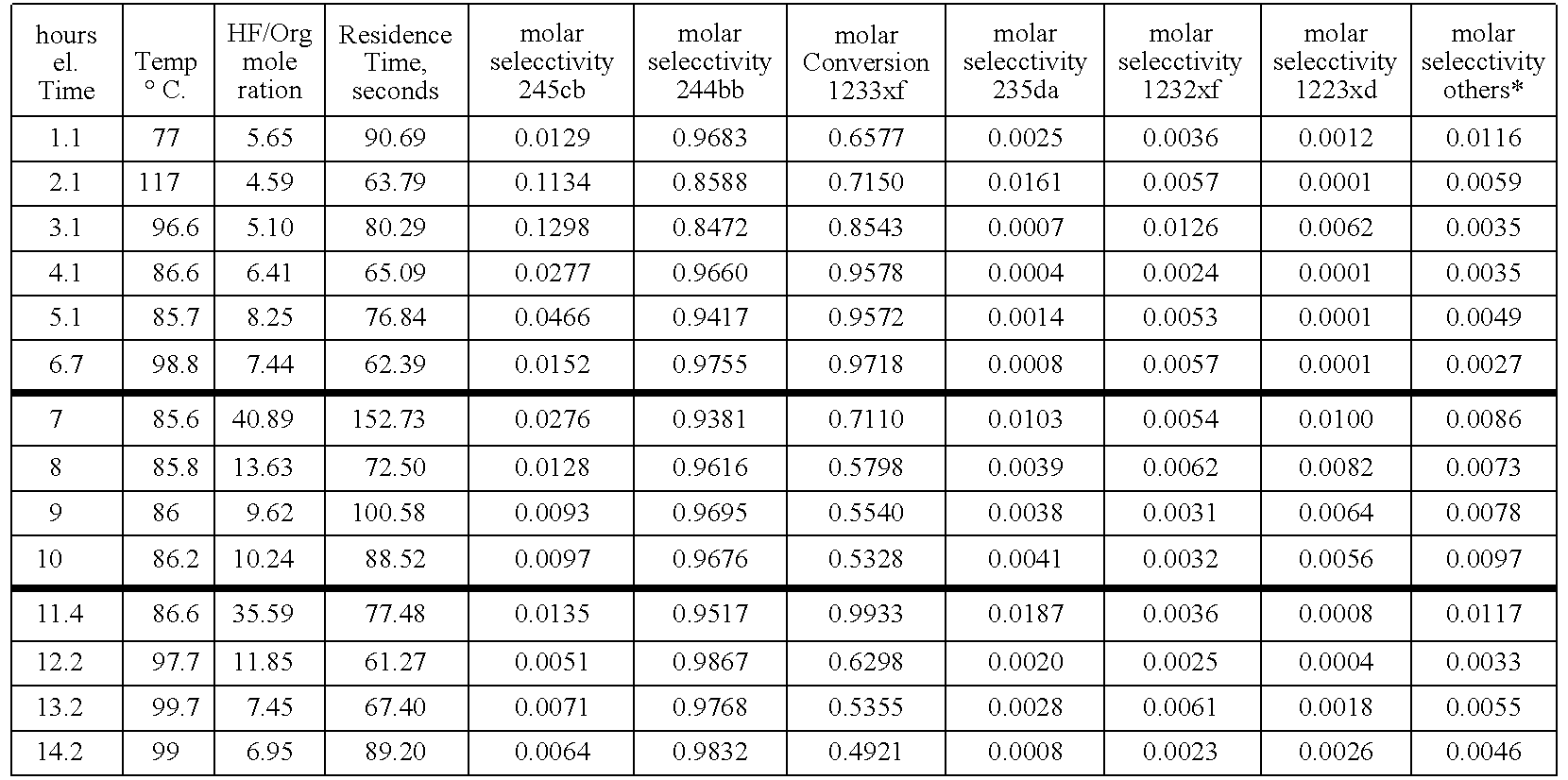Processes for hydrofluorination of 2-chloro-3,3,3-trifluoropropene to 2-chloro-1,1,1,2-tetrafluoropropane
a technology of trifluoropropene and hydrofluorination process, which is applied in the field of hydrofluorination process of 2chloro3, 3, 3trifluoropropene to 2chloro1, 1, 1, 2tetrafluoropropane, can solve the problems of difficult and costly separation and removal
- Summary
- Abstract
- Description
- Claims
- Application Information
AI Technical Summary
Benefits of technology
Problems solved by technology
Method used
Image
Examples
example 1
[0024]In Example 1, a catalyst system of SbCl5 / SbCl3 in a 5:1 mole ratio was employed. About 1988 grams of new SbCl5 were mixed with about 280 grams of new SbCl3. The mixture was heated to achieve homogeneity. The combined mix was added into Reactor R11. R11 is a Teflon™-lined liquid phase reactor (Teflon is a trademark of E. I. duPont de Nemours & Co) equipped with a 2-inch ID (inside diameter) catalyst stripper (a packed column to keep catalyst from escaping from the reactor system). The reactor is 2.75-inch ID×36-inch L (length). The reactor was heated to about 85° C.-87° C. HF feed was started first. After 1.3 lbs (pounds) of HF had been added to fluorinate the catalyst charge, the 2-chloro-3,3,3-trifluoropropene feed was started. The purity of the 2-chloro-3,3,3-trifluoropropene feed stock was about 98 GC area % (gas chromatograph). The experiment (Run#47) ran continuously for about 14 hours. For this run, Cl2 was fed batchwise about every 4 hours throughout the run in case nee...
example 2
[0025]In Example 2, a catalyst system of SbCl5 / SbCl3 in a 5:1 mole ratio was employed. About 1937 grams of new SbCl5 were mixed with about 292 grams of new SbCl3. The mixture was heated to achieve homogeneity. The combined mixture was added into Reactor R11. R11 is a Teflon™-lined liquid phase reactor (Teflon is a trademark of E. I. duPont de Nemours & Co) equipped with a 2-inch ID (inside diameter) catalyst stripper (a packed column to keep catalyst from escaping from the reactor system). The reactor is 2.75-inch ID×36-inch L (length). The reactor was heated to about 85° C.-87° C. HF feed was started first. After 1.3 lbs (pounds) of HF had been added to fluorinate the catalyst charge, the 2-chloro-3,3,3-trifluoropropene feed was started. The purity of the 2-chloro-3,3,3-trifluoropropene feed stock was about 98 GC area % (gas chromatograph). The experiment (Run#48) ran continuously for about 129 hours. For this run, Cl2 was fed batchwise about every 4 hours throughout the run in cas...
example 3
[0026]A 2% mix of 1,1,2,3-tetrachloropropene in 98% 2-chloro-3,3,3-trifluoropropene by weight is used early in the run to reduce the activity of the catalyst system, and, thereby, the formation of 1,1,1,2,2-pentafluoropropane. About 2261 grams of new SbCl5 were added into Reactor R11. R11 is a Teflon™-lined liquid phase reactor (Teflon is a trademark of E.I. duPont de Nemours & Co) equipped with a 2-inch ID (inside diameter) catalyst stripper (a packed column to keep catalyst from escaping from the reactor system). The reactor is 2.75-inch ID×36-inch L (length). The reactor was heated to about 85° C.-87° C. HF feed was started first. After 1.4 lbs (pounds) of HF had been added to fluorinate the catalyst charge, the 2-chloro-3,3,3-trifluoropropene feed was started. The experiment (Run#50) ran continuously for about 22 hours. The HF feed for the run averaged 1.36 lb / hr and the 2-chloro-3,3,3-trifluoropropene feed averaged 0.79 lb / hr. for a 11.2 / 1 ratio of HF / 2-chloro-3,3,3-trifluoropr...
PUM
| Property | Measurement | Unit |
|---|---|---|
| temperature | aaaaa | aaaaa |
| residence time | aaaaa | aaaaa |
| residence time | aaaaa | aaaaa |
Abstract
Description
Claims
Application Information
 Login to View More
Login to View More - R&D
- Intellectual Property
- Life Sciences
- Materials
- Tech Scout
- Unparalleled Data Quality
- Higher Quality Content
- 60% Fewer Hallucinations
Browse by: Latest US Patents, China's latest patents, Technical Efficacy Thesaurus, Application Domain, Technology Topic, Popular Technical Reports.
© 2025 PatSnap. All rights reserved.Legal|Privacy policy|Modern Slavery Act Transparency Statement|Sitemap|About US| Contact US: help@patsnap.com

